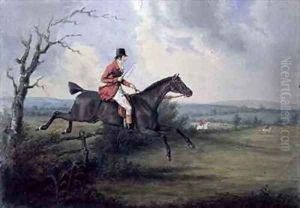Sir Robert Frankland-Russell Paintings
Sir Robert Frankland-Russell, born Robert Frankland in 1784, was a British artist and aristocrat known for his contributions to painting, particularly in the genre of landscapes, during the late 18th and early 19th centuries. His artistic journey is nestled within the broader context of the Romantic period, a time when art began to emphasize emotion and individualism, a reaction against the industrial revolution and the rigid structures of neoclassicism. Frankland-Russell's works, though not as widely recognized as those of his contemporaries, encapsulate the spirit of Romanticism with their focus on nature, the sublime, and a nuanced appreciation for the British countryside.
Educated at Trinity College, Cambridge, Sir Robert not only pursued a career in art but also fulfilled his duties as a baronet, a title he inherited in 1825, which led to the addition of 'Russell' to his surname, becoming Sir Robert Frankland-Russell. This period marked a significant transition in his life, intertwining his artistic passions with the responsibilities of landownership and societal status. Despite these obligations, he remained dedicated to his craft, often integrating his social and natural environments into his artworks.
Frankland-Russell was also known for his engagement with the scientific and cultural advancements of his time. He was a contemporary of figures such as J.M.W. Turner and John Constable, artists who were also exploring and evolving the landscape genre in Britain. Though Frankland-Russell did not achieve the same level of fame as these counterparts, his works contribute valuable insights into the era's artistic and societal shifts. His paintings often depicted serene landscapes imbued with a sense of tranquility and a profound respect for nature, reflecting the Romantic era's fascination with the natural world as a source of beauty, inspiration, and emotional experience.
Sir Robert Frankland-Russell's legacy, while subtle, is preserved in various collections and exhibits that showcase the depth and diversity of British landscape painting. His death in 1849 marked the end of a life that navigated the intersections of art, aristocracy, and the burgeoning cultural movements of the 19th century. Today, researchers and art enthusiasts continue to explore his contributions within the broader narrative of British art history, recognizing him as a figure who, in his own unique way, captured the essence of his time through the lens of landscape painting.
